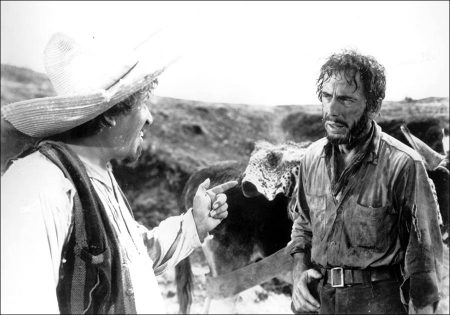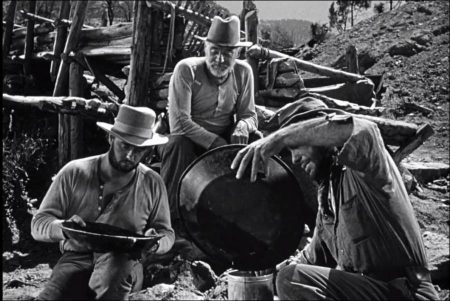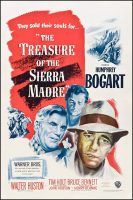Taglines: The nearer they get to their treasure, the farther they get from the law.
The Treasure of the Sierra Madra movie storyline. Dobbs and Curtin meet up in Mexico, and go to work for a contractor, Pat McCormick, who takes them away to remote site and tells them they will be paid when the job is finished. When they are finished, they return to town to find McCormick to get their wages. McCormick gives them a few dollars, and says he’ll just go to the bank and pick up the payroll for them.
Dobbs and Curtin then meet up with an old prospector, who claims the hills are still full of gold, and if they can get the cash, he’ll go with them. They eventually get the cash from McCormick after a little “persuasion”, and all three set off for the hills as good friends, but will they return that way?
The Treasure of the Sierra Madre is a 1948 American western adventure drama written and directed by John Huston. It is an adaptation of B. Traven’s 1927 novel of the same name, set in the 1920s, in which, driven by their desperate economic plight, two young men, Fred C. Dobbs (Humphrey Bogart) and Bob Curtin (Tim Holt), join old-timer Howard (Walter Huston, the director’s father) in Mexico to prospect for gold.
The Treasure of the Sierra Madre was one of the first Hollywood productions to be shot on location outside the United States (in the state of Durango with street scenes in Tampico, Mexico), although many scenes were filmed back in the studio and elsewhere in the U.S. In 1990, the film was selected for preservation in the United States National Film Registry by the Library of Congress as being “culturally, historically, or aesthetically significant”.
About the Filming
The Treasure of the Sierra Madre was one of the first Hollywood films to be filmed on location outside the United States (in the state of Durango and street scenes in Tampico, Mexico), although many scenes were filmed back in the studio and elsewhere in the US. Filming took five and a half months to shoot.
The first scene in the film with Bogart and Holt was the first to be shot. The opening scenes, filmed in longshot on the Plaza de la Libertad in Tampico, show contemporary (i.e. of the 1940s) cars and buses, even though the story opens in 1925, as evidenced by the lottery number’s poster.
Just as Huston was starting to shoot scenes in Tampico, Mexico, the production was shut down inexplicably by the local government. The cast and crew were at a complete loss to understand why, since the residents and government of Tampico had been so generous in days past. It turns out that a local newspaper printed a false story that accused the filmmakers of making a production that was unflattering to Mexico.
Huston soon found out why the newspaper skewered him and his production. When you wanted to do anything in Tampico, it was customary to slide a little money toward the editor of the newspaper, something the crew failed to do. Fortunately, two of Huston’s associates, Diego Rivera and Miguel Covarrubias, went to bat for the director with the President of Mexico. The libelous accusations were dropped, and a few weeks later, the editor of the newspaper was caught in flagrante and shot dead by a jealous husband.
Most of the Mexican extras were paid 10 pesos a day which was the equivalent of $2.00, a considerable amount for an impoverished region at the time. There were scenes in which Walter Huston had to speak fluent Spanish, a language he did not know off camera. John Huston hired a Mexican to record the lines and then the elder Huston memorized them so well that many assumed he knew the language like a native. As with most of the Mexican actors selected from the local population, Alfonso Bedoya’s heavily accented pronunciation of English proved to be a bit of a problem. Example: “horseback” came out as “whore’s back”. Bogart only knew two Spanish words, “Dos Equis”, a Mexican beer.
The fight scene in the cantina took five days to shoot. During the shooting of the entire film, John Huston pulled pranks on Bennett, Bedoya (along with Bogart) and Bogart. While most of the film was shot in Mexico, Jack L. Warner had the unit return to Hollywood when the budget started to exceed three million dollars.
Though the daily rushes impressed Warner Bros., Jack L. Warner nearly went berserk with the weekly expenditures. After viewing one scene, Warner threw up his hands and shouted to Producer Henry Blanke, “Yeah, they’re looking for gold all right – mine!” During another screening of rushes, Warner watched Dobbs stumble along in the desert for water. Warner jumped up in the middle of the scene and shouted to a gaggle of executives, “If that s.o.b. doesn’t find water soon I’ll go broke!”.
Warner had reason to be upset. John Huston and Blanke led him to believe that the film would be an easy picture to make and that they would be in and out of Mexico in a matter of weeks. Warner was notorious for not actually reading scripts and he assumed the film was a B-movie Western. As the full extent of Huston’s plans became apparent, Warner became quite angry. He was especially unhappy with the way the film ended, arguing that audiences wouldn’t accept it. Warner’s expectation was validated in that the initial box office take was unimpressive. Yet the film was a huge critical success and in its many re-releases, it more than earned back its original investment of $3 million.
As production dragged on, Bogart, who was an avid yachtsman, was starting to get increasingly anxious about missing the Honolulu Race in which he usually took part. Despite assurances from the studio that his work on the picture would be finished by then, he started to repeatedly annoy Huston about whether he would be done in time. Eventually Huston had enough and grabbed Bogart by the nose and twisted hard. Bogart never again asked him to confirm when shooting was expected to be over.
The wind storm in the final scene was created by borrowing some jet engines from the Mexican Air Force. Traven was asked if he would like to visit the set during location shooting. He demurred but said he would be sending an associate instead. The associate was actually Traven himself, using a pseudonym. It is debated if this is speculation or not.
The Treasure of the Sierra Madra (1948)
Directed by: John Huston
Starring: Humphrey Bogart, Walter Huston, Tim Holt, Bruce Bennett, Barton MacLane, Alfonso Bedoya, Arturo Soto Rangel, Manuel Dondé, José Torvay, Margarito Luna, Robert Blake, Jacqueline Dalya
Screenplay by: John Huston
Cinematography by: Ted D. McCord
Film Editing by: Owen Marks
Set Decoration by: Fred M. MacLean
Art Direction by: John Hughes
Music by: Max Steiner
MPAA Rating: None.
Distributed by: Warner Bros. Pictures
Release Date: January 6, 1948
Views: 217



